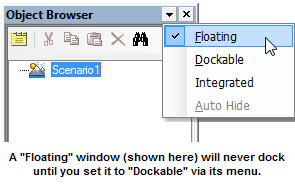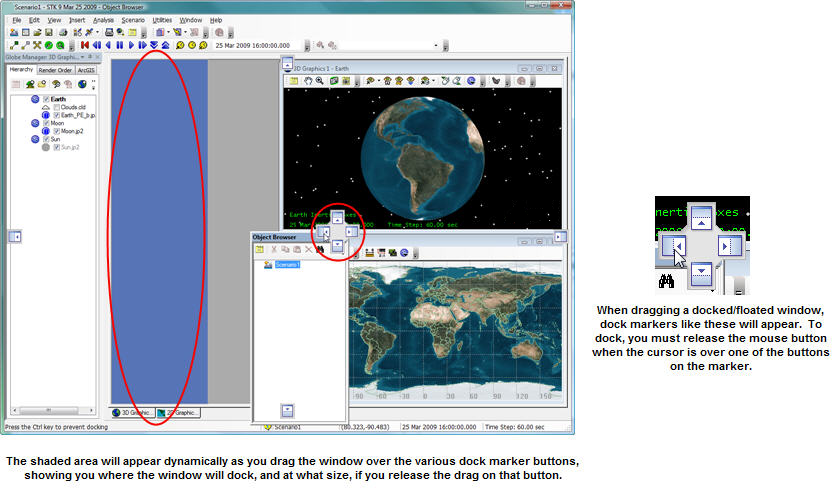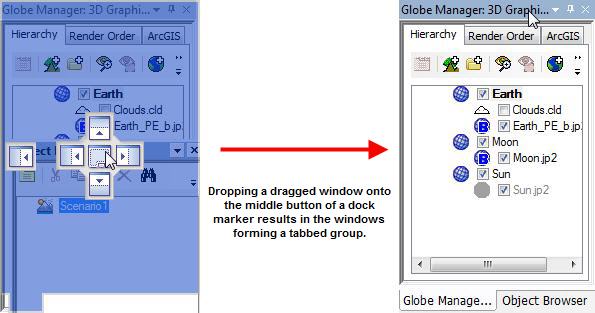Working with STK Windows
Working with many STK windows open can clutter the STK workspace. Use the settings described in this topic to arrange the windows in your STK workspace to suit your needs and keep clutter to a minimum.
Individual windows that are dockable have three basic display types. Click these links to learn more about them.
- Dockable
- Docking a window
- Pinned and hidden windows
- Tabbed windows
- No automatic docking
- Floating
- Integrated
You can select or change the display type by right-clicking the top section of the window. When in Dockable or Floating mode, you can also use the down arrow at the top of the window to select the mode.

For information on using the Window menu in STK to make changes to STK windows, see the Window menu section of this topic.
STK also provides a Full Screen viewing mode to change the appearance of the entire workspace. Use this for presentation purposes or in any situation where you want to completely focus on a graphics window.
Dockable
When you select Dockable as an individual window display type, you can fix that window at certain places in the STK workspace.
When you drag a window that is Dockable, whether it is currently docked or not, the STK workspace displays helpful dock markers that highlight exactly where you can place the window for docking. For the procedure of docking a window, see the explanations in this picture.

In the example above, the shaded area to the left shows where the window will dock in relation to the workspace. The four markers in the middle of the workspace provide docking possibilities next to currently docked windows, if any. The four markers at the edges of the workspace provide docking possibilities in line with currently docked windows, if any.
Pinned and hidden windows
Docked windows are said to be "pinned" in place, represented by a vertical pushpin.

A pinned window means that it is docked and visible at all times in the application's workspace. If you click the pushpin, you toggle it to the "unpinned" state (horizontal pushpin), which hides the window from view. Instead of seeing the full window, you simply see its title. Hover the mouse cursor over the title of the window to bring it back into view. When you switch to another window, the unpinned window hides again. To restore it back to a pinned state, click the pushpin again while the window is visible.
Two or more windows can be in the unpinned state at the same time and location, with each having its title listed along the window edge.


Tabbed groups
It is also possible when docking near another previously docked window to group them together in a tabbed formation by selecting a special icon in the center of the dock markers:

To remove a window from a tabbed group, drag from its tab (not its title bar) to separate it. If you drag from the title bar of the docked windows, the entire tabbed group moves as one cohesive unit.
No automatic docking
If you move a docked window, it will only dock again if you drag and drop the window onto a dock marker. It remains in a "Dockable" state, but will appear to float.
Floating mode
If a window is in Floating mode, you can drag it anywhere inside or outside the STK workspace. If you manually set a window to "Floating" mode, it will not dock as you move it around, and the dock markers will not appear.

Some windows may open directly into Floating mode. If you want to dock a Floating window, change it to "Dockable."
If you move a floating window outside the STK workspace and you are having trouble finding it, you can bring the window back to the STK workspace; see Window menu for details on this.
Integrated mode
If a window is in Integrated mode, you can move it anywhere in the STK workspace, but not outside the workspace. The 2D and 3D graphics windows normally default to this mode. If you manually set a window to "Integrated" mode, it will not dock as you move it around, and the dock markers will not appear.
Window menu
When you go to the Window menu in STK and select Windows..., the Windows dialog box will open. You will see a list of all the STK windows currently open, giving the name of the window (Object Browser, 3D Graphics, etc.) and the type (Docked, Floating, or Integrated). When you select a window in the list, you will see one or more of the following options on the right become available:
| Option | Available for... | Description |
|---|---|---|
| Activate | Integrated |
This option does two things at once:
|
| Integrate | Floating | Changes a floating window to an integrated window. If the selected floating window is outside of the STK workspace, this action will bring that window back inside the STK workspace. |
| Center | Floating | Places the selected window at the middle point of the STK workspace. |
| Close | All types | Closes the selected window. |
Full-screen view
Select Full Screen under the View menu to fill the screen with the current 2D or 3D graphics window while hiding all other parts of the STK interface. Maximize the graphics window you want to fill the screen. Use the Escape button on your keyboard to leave the Full Screen mode.
While in Full Screen mode, you can access the Menu Bar using the menu keyboard shortcuts. For example, you can switch between maximized graphics windows by selecting [Alt]-W on the keyboard, to bring up the Window menu, and then selecting from the list of available graphics windows.
You can drag the menu bar from the top of the screen to float it over the graphics window, and you can close the menu bar by right-clicking it and clearing Menu Bar in the menu list that appears.